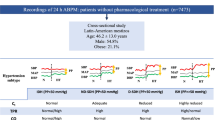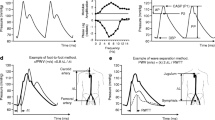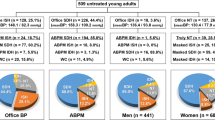Abstract
To determine whether a classification based on the contour of the photoplethysmography signal (PPGc) can detect changes in systolic arterial blood pressure (SAP) and vascular tone. Episodes of normotension (SAP 90–140 mmHg), hypertension (SAP > 140 mmHg) and hypotension (SAP < 90 mmHg) were analyzed in 15 cardiac surgery patients. SAP and two surrogates of the vascular tone, systemic vascular resistance (SVR) and vascular compliance (Cvasc = stroke volume/pulse pressure) were compared with PPGc. Changes in PPG amplitude (foot-to-peak distance) and dicrotic notch position were used to define 6 classes taking class III as a normal vascular tone with a notch placed between 20 and 50% of the PPG amplitude. Class I-to-II represented vasoconstriction with notch placed > 50% in a small PPG, while class IV-to-VI described vasodilation with a notch placed < 20% in a tall PPG wave. 190 datasets were analyzed including 61 episodes of hypertension [SAP = 159 (151–170) mmHg (median 1st–3rd quartiles)], 84 of normotension, SAP = 124 (113–131) mmHg and 45 of hypotension SAP = 85(80–87) mmHg. SAP were well correlated with SVR (r = 0.78, p < 0.0001) and Cvasc (r = 0.84, p < 0.0001). The PPG-based classification correlated well with SAP (r = − 0.90, p < 0.0001), SVR (r = − 0.72, p < 0.0001) and Cvasc (r = 0.82, p < 0.0001). The PPGc misclassified 7 out of the 190 episodes, presenting good accuracy (98.4% and 97.8%), sensitivity (100% and 94.9%) and specificity (97.9% and 99.2%) for detecting episodes of hypotension and hypertension, respectively. Changes in arterial pressure and vascular tone were closely related to the proposed classification based on PPG waveform.
Clinical Trial Registration NTC02854852.




Similar content being viewed by others
References
Walsh M, Devereaux PJ, Garg AX, Kurz A, Turan A, Rodseth RN, Cvwinski J, Thabane L, Sessler DI. Relationship between intraoperative mean arterial pressure and clinical outcomes after noncardiac surgery. Toward an empirical definition of hypotension. Anesthesiology. 2013;119:507–15.
Basali A, Masch EJ, Kalfas I, Schubert A. Relation between perioperative hypertension and intracranial hemorrhage after craniotomy. Anesthesiology. 2000;93:48–53.
Reich DL, Bennet-Guerrero E, Bodin C, Hossain S, Winfree W, Krol M. Intraoperative tachycardia and hypertension are independently associated wih adverse outcome in noncardiac surgery of long duration. Anesth Analg. 2002;95:273–7.
Bijker JB, van Klei WA, Kappen TH, van Wolfswinkel L, Moons KGM, Kalkman CJ. Incidence of intraoperative hypotension as a function of the chosen definition. Anesthesiology. 2007;107:213–20.
van Waes JAR, van Klei WA, Wijeysundera DN, van Wolfswinkel L, Lindsay TF, Beattie WS. Association between intraoperative hypotension and myocardial injury after vascular surgery. Anesthesiology. 2016;124:35–44.
Bartels K, Esper SA, Thiele RH. Blood pressure monitoring for the anesthesiologist: a practical review. Anesth Analg. 2016;122:1866–79.
Akata T. General anesthetics and vascular smooth muscle. Direct actions of general anesthetics on cellular mechanisms regulating vascular tone. Anesthesiology. 2007;106:365–91.
Lindorf HH. Investigation of the vascular effect of newer local anesthetics and vasoconstrictors. Oral Surg Oral Med. 1979;46:292–7.
Holte K, Foss NB, Svensen C, Lund C, Madsen JL. Epidural anesthesia, hypotension, and changes in intravascular volume. Anesthesiology. 2004;100:281–6.
Allen J. Photopletysmography and its application in clinical physiological measurement. Physiol Meas. 2007;28:R1–39.
Awad AA, Haddadin AS, Tantawy H, Badr TM, Stout RG, Silverman DG, Shelley KH. The relationship between the photoplethysmographic waveform and systemic vascular resistance. J Clin Monit Comput. 2007;21:365–72.
Lee QY, Chan GSH, Redmond SJ, Middleton PM, Steel E, Malouf P, Critoph C, Flynn G, O’Lone E, Lovell NH. Multivariate classification of systemic vascular resistance using photoplethysmography. Physiol Meas. 2011;32:1117–32.
Middleton PM, Chan GSH, Steel E, Malouf P, Critoph C, Flynn G, O’Lone E, Celler BC, Lovell NH. Fingertip photoplethysmographic waveform variability and systemic vascular resistance in intensive care unit patients. Med Biol Eng Comput. 2011;49:859–66.
De Trafford J, Lafferty K. What does photoplethysmography measure? Med Biol Eng Comput. 1984;22:479–80.
Wisely NA, Cook LB. Arterial flow waveforms from pulse oximetry compared with measured Doppler flow waveforms. Anaesthesia. 2001;56:556–61.
O’Rourke MF, Yaginuma T, Avolio AP. Physiological and pathophysiological implications of ventricular/vascular coupling. Ann Biomed Eng. 1984;12:119–34.
Korpas D, Hâlek J, Dolezal L. Parameters describing the pulse wave. Physiol Res. 2009;58:473–9.
Van den Bos GC, Westerhof N, Randall OS. Pulse-wave reflection: can it explain the differences between systemic and pulmonary pressure and flow waves? Circ Res. 1982;51:479–85.
Tusman G, Bohm SH, Suarez Sipmann F. Advanced uses of pulse oximetry for monitoring mechanically ventilated patients. Anesth Analg. 2017;201:62–71.
Dawber TR, Thomas HE Jr, McNamara PM. Characteristics of the dicrotic notch of the arterial pulse wave in coronary heart disease. Angiology. 1973;24:244–55.
Morikawa Y. Characteristic pulse wave caused by organic nitrates. Nature. 1967;213:841–2.
Morikawa Y, Matsuzaka J, Kuratsune M, Tsukamoto S, Makisumi S. Plethysmographic study of effects of alcohol. Nature. 1968;220:186–7.
Dillon JB, Hertzman AB. The form of the volume pulse in the finger pad in health, arteriosclerosis, and hypertension. Am Heart J. 1941;21:172–90.
Mancia G, Fagard R, Narkiewicz K. ESH/ESC guidelines for the management of arterial hypertension. Eur Heart J. 2013;34:2159–219.
Milnor WR. Arterial impedance as ventricular afterload. Circ Res. 1975;36:565–70.
Randall OS, Westerhof N, van den Bos GC, Alexander B. Reliability of stroke volume to pulse pressure ratio for estimating and detecting changes in arterial compliance. J Hypertens. 1986;4:293–6.
Marik PE, Monnet X, Teboul JL. Hemodynamic parameters to guide fluid theraphy. Ann Intensive Care. 2011;1:1.
Broch O, Renner J, Gruenewald M, Meybohm P, Höcker J, Schöttler J, Steinfath M, Bein B. Variation of left ventricular outflow tract velocity and global end-diatolic volume index reliability predict fluid responsiveness in cardiac surgery patients. J Crit Care. 2012;27:325e7–14.
Sakka SG, Rühl CC, Pfeiffer UJ, Beale R, McLuckie A, Reinhart K, Meier-Hellmann A. Assessment of cardiac preload and extravascular lung water by single transpulmonary thermodilution. Intensive Care Med. 2000;26:180–7.
Bur A, Herkner H, Vlcek M, Woisetschläger C, Derhasching U, Delle KG, Lagger A, Hirschi MM. Factors influencing the accuracy of oscillometric blood pressure measurement in critically ill patients. Crit Care Med. 2003;31:793–9.
Liu J, Hahn JO, Mukkamala R. Error mechanism of the oscillometric fixed-ratio blood pressre measurement method. Ann Biomed Eng. 2013;41:587–97.
Pytte M, Dybwik K, Sexton J, Straume B, Nielsen W. Oscillometric brachial mean artery pressures are higher than intra-radial mean artery pressures in intensive care unit patients receiving norepinephrine. Acta Anaesthesiol Scand. 2006;50:718–21.
Araghi A, Bander JJ, Guzman JA. Arterial blood pressure monitoring in overweight critically ill patients: invasive or noninvasive. Crit Care. 2006;10:R64.
Natalini G, Rosano A, Taranto M, Faggian B, Vittorelli E, Bernardini A. Arterial versus plethysmographic dynamic indices to test responsiveness for testing fluid administration in hypotensive patients: a clinical trial. Anesth Analg. 2006;103:1478–84.
Cannesson M, Besnard C, Durand PG, Bohé J, Jacques D. Relation between respiratory variations in pulse oximetry plethysmographic waveform amplitude and arterial pulse pressure in ventilated patients. Crit Care. 2005;9:R562–8.
Millasseau SC, Kelly RP, Ritter JM, Chowienczyk PJ. Determination of age-related increases in large artery stiffness by digital pulse contour analysis. Clin Sci (Lond). 2002;103:371–7.
Allen J, Murray A. Age-related changes in peripheral pulse shape characteristics at various body sites. Physiol Meas. 2003;24:297–307.
Hashimoto J, Chonan K, Aoki Y, Nishimura T, Ohkubo T, Hozawa A, Suzuki M, Matsubara M, Michimata M, Araki T, Imai Y. Pulse wave velocity and the second derivative of the finger photoplethysmogram in treated hypertensive patients: their relationship and associating factors. J Hypertens. 2002;20:2415–22.
Peñaz J. Criteria for set point estimation in the volume clamp method of blood pressure measurement. Physiol Meas. 1992;41:5–10.
Pinna GD, Maestri R, Mortara A. Estimation of arterial blood pressure variability by spectral analysis: comparison between Finapres and invasive measurements. Physiol Meas. 1996;17:147–9.
Wallace C, Barker D, Apert C, Tankersley SJ, Conroy JM, Kerns RE. Comparison of blood pressure measurement by Doppler and by pulse oximetery techniques. Anesth Analg. 1987;66:1018–9.
Talke P, Nichols RJ, Traber DL. Does measurement of systolic blood pressure with a pulse oximeter correlate with conventional methods? J Clin Monit. 1990;6:5–9.
Bortolotto LA, Blacher J, Kondo T, Takazawa K, Safar ME. Assessment of vascular aging and atherosclerosis in hypertensive subjects: second derivative of photoplethysmogram versus pulse wave velocity. Am J Hypertens. 2000;13:165–71.
Awad AA, Ghobashy AM, Stout RG, Silverman DG, Shelley KH. How does plethysmogram derived from the pulse oximeter relate to arterial blood pressure in coronary artery bypass graft patients? Anesth Analg. 2001;93:1466–71.
Lopez-Beltrán EA, Blackshear PL, Finkelstein SM, Cohn JN. Non-invasive studies of peripheral vascular compliance using a non-occluding photoplethysmographic method. Med Biol Eng Comput. 1998;36:748–53.
Jagomägi K, Raamat R, Talts J, Ragun U, Länsimies E, Jurvelin J. Recording of dynamic arterial compliance changes during hand elevation. Clin Physiol Funct Imaging. 2005;25:350–6.
Bendjelid K. The pulse oximetry plethysmographic curve revisited. Curr Opin Crit Care. 2008;14:348–53.
Fischer GW, Levin MA. Vasoplegia during cardiac surgery: current concepts and management. Semin Thorac Surg. 2010;22:140–4.
Overgaard CB, Dzavík V. Inotropes and vasopressors. Review of physiology and clinical use in cardiovascular disease. Circulation. 2008;118:1047–56.
Morimatsu H, Uchino S, Chung J, Bellomo R, Raman J, Buxton B. Norephinephrine for hypotensive vasodilation after cardiac surgery: impact on renal function. Intensive Care Med. 2003;29:1106–12.
Wajima Z, Shiga T, Imanaga K, Inoue T. Do induce hypertension and hypotension affect stroke volume variation in man? J Clin Anaesth. 2012;24:207–11.
Bouchcourt JP, Riva JA, Grignola JC. The increase of vasomotor tone avoids the ability of the dynamic preload indicators to estimate fluid responsiveness. BMC Anesthesiol. 2013;13:41.
Bagshaw SM, Brophy PD, Ronco CD. Fluid balance as a biomarker: impact of fluid overload on outcome in critically ill patients with acute kidney injury. Crit Care. 2008;12:169.
Morin JF, Mistry B, Langllois Y, Ma F, Chaumoun P, Holcroft C. Fluid overload after coronary artery bypass grafting surgery increases the incidence of postoperative complications. World J Cardiovasc Surg. 2011;1:18–23.
Author information
Authors and Affiliations
Corresponding author
Ethics declarations
Conflict of interest
No potential conflicts of interest exist except for Matías Madorno who is partner and manager of MBMed S.A; a company that produce respiratory monitoring equipments.
Informed consent
Informed consent was obtained from all individual participant included in the study.
Rights and permissions
About this article
Cite this article
Tusman, G., Acosta, C.M., Pulletz, S. et al. Photoplethysmographic characterization of vascular tone mediated changes in arterial pressure: an observational study. J Clin Monit Comput 33, 815–824 (2019). https://doi.org/10.1007/s10877-018-0235-z
Received:
Accepted:
Published:
Issue Date:
DOI: https://doi.org/10.1007/s10877-018-0235-z




